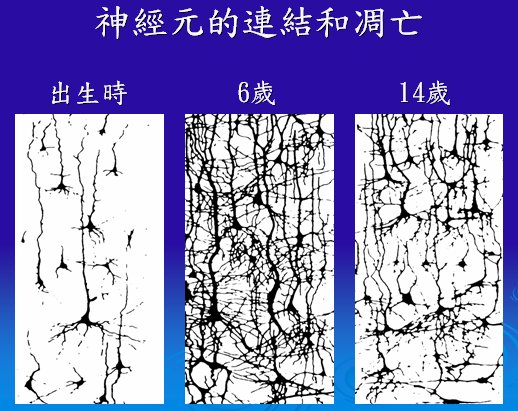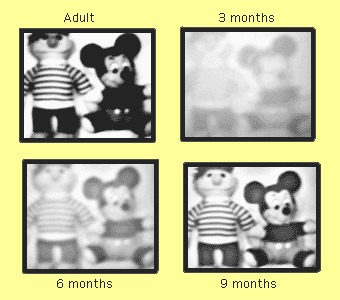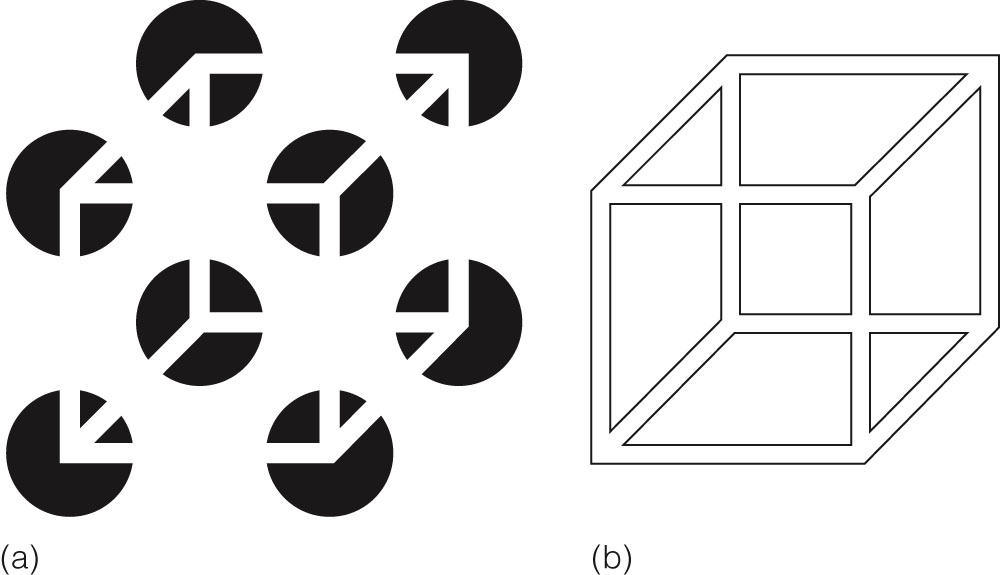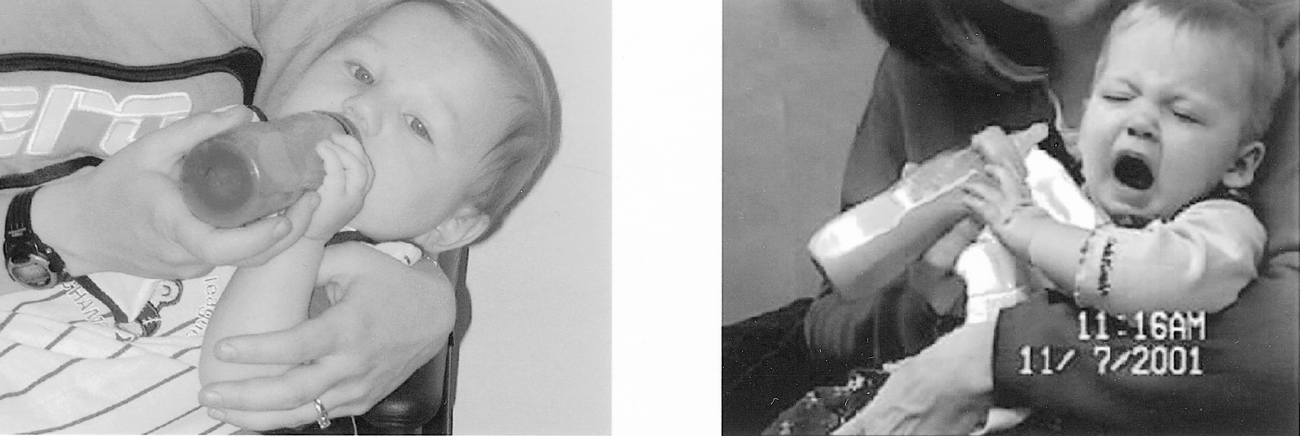第十六講:Perceptual Development
出自KMU Wiki
(修訂版本間差異)
| 在2012年1月8日 (日) 20:52所做的修訂版本 (編輯) 98007013 (對話 | 貢獻) ←上一個 |
當前修訂版本 (2012年1月9日 (一) 05:17) (編輯) (撤銷) Fivesix27 (對話 | 貢獻) (→發展的主題) |
||
| 第9行: | 第9行: | ||
| **..... | **..... | ||
| - | *方法一:Preferential | + | *方法一:Preferential looking《Figure16.1》 |
| - | *方法二:VEP (visual evoked potential) | + | *方法二:VEP (visual evoked potential)《Figure16.2》 |
| == 神經的發展 == | == 神經的發展 == | ||
| + | 《Figure16.3》 | ||
| + | [[Image:Perceptual Development1.jpg]] | ||
| + | |||
| + | *cones 的發展與acuity《Figure16.4》 | ||
| + | *光柵與空間頻率《Figure16.5》 | ||
| + | **(細節請參照wiki說明) | ||
| + | **空間頻率與對比《Figure16.6》 | ||
| + | *CSF (contrast sensitivity functions)《Figure16.7》 | ||
| + | **由子紹推估嬰兒所見 | ||
| + | [[Image:Perceptual Development2.gif]] | ||
| + | |||
| + | |||
| + | *isoluminant的意義《Figure16.9》 | ||
| + | |||
| + | *方法三:habituation《Figure16.10》 | ||
| + | **上頁所操弄《Figure16.11》 | ||
| + | |||
| + | *Fox(1980)的立體視覺實驗《Figure16.12》 | ||
| + | **用RDS | ||
| + | 3個月以後可以追蹤 | ||
| + | |||
| + | *熟習物大小與距離《Figure16.13》 | ||
| + | *對於人臉《Figure16.14》 | ||
| + | **其實重點在上半部《Figure16.15》 | ||
| + | |||
| + | *錯覺輪廓(Illusory Contour) | ||
| + | [[Image:Perceptual Development3.jpg]] | ||
| + | |||
| + | *Good continuation (5.16) | ||
| + | **p.390 figure 16.16 | ||
| + | |||
| + | === Kellman and Spelke (1983) === | ||
| + | *《Figure16.17》 | ||
| + | *perceivers VS nonperceivers 《Figure16.18》 | ||
| + | **Johnson et al.(2004) 注視點不同 | ||
| + | |||
| + | == 嬰兒聽力 == | ||
| + | 《Figure16.19》 | ||
| + | |||
| + | ==== 利用sucking rate ==== | ||
| + | *2-day-old | ||
| + | *分兩組 | ||
| + | **一組 | ||
| + | ***吸吮長停->放媽媽的聲音 | ||
| + | ***吸吮短停->陌生人聲音 | ||
| + | **另一組 | ||
| + | ***吸吮長停->放陌生人的聲音 | ||
| + | ***吸吮短停->媽媽聲音 | ||
| + | *均學會(見圖16.20) | ||
| + | |||
| + | *分辨VOT《Figure16.21》 | ||
| + | **一個月大小 | ||
| + | |||
| + | ==== T.G.R.Bower(1994) ==== | ||
| + | *吸了就出來,如果與吸的一樣的會繼續吸《Figure16.22》 | ||
| + | |||
| + | *嘴形與聲音同步《Figure16.23》 | ||
| + | *媽媽有沒有說話《Figure16.24》 | ||
| + | **出生12小時 | ||
| + | |||
| + | == 嗅覺與味覺 == | ||
| + | |||
| + | *Newborns可能就有一些分辨能力 | ||
| + | **嗅覺p.396 figure 16.25 | ||
| + | ***至少會逃避Rotten egg | ||
| + | **味覺p.396 figure 16.26 | ||
| + | ***吃苦:( | ||
| + | |||
| + | *Taste preferences | ||
| + | **很小就有 | ||
| + | [[Image:Perceptual Development4.jpg]] | ||
| + | *區辨「臉」《Figure16.27》 | ||
| + | **大人與嬰兒之差異《Figure16.28》 | ||
| + | |||
| + | == nature or nurture == | ||
| + | *知覺發展 | ||
| + | **何時出現算是nature? | ||
| + | ***3個月 | ||
| + | ***一個月 | ||
| + | ***12天 | ||
| + | ***1天 | ||
| + | ***12小時 | ||
| + | *種間差異species difference | ||
| + | **用平板研究動物行為 | ||
| + | |||
| - | *cones 的發展與acuity | ||
| - | *光柵與空間頻率(細節請參照wiki說明) | ||
| [[ 知覺心理學 ]] | [[ 知覺心理學 ]] | ||
當前修訂版本
目錄 |
[編輯] 發展的主題
- nature or nurture
- 那些部分是基因決定?
- 方法上的困難
- 你可以問新生兒?
- 可以叫新生兒按鍵?
- 學理上的困難
- 後天何時介入?
- .....
- 方法一:Preferential looking《Figure16.1》
- 方法二:VEP (visual evoked potential)《Figure16.2》
[編輯] 神經的發展
- cones 的發展與acuity《Figure16.4》
- 光柵與空間頻率《Figure16.5》
- (細節請參照wiki說明)
- 空間頻率與對比《Figure16.6》
- CSF (contrast sensitivity functions)《Figure16.7》
- 由子紹推估嬰兒所見
- isoluminant的意義《Figure16.9》
- 方法三:habituation《Figure16.10》
- 上頁所操弄《Figure16.11》
- Fox(1980)的立體視覺實驗《Figure16.12》
- 用RDS
3個月以後可以追蹤
- 熟習物大小與距離《Figure16.13》
- 對於人臉《Figure16.14》
- 其實重點在上半部《Figure16.15》
- 錯覺輪廓(Illusory Contour)
- Good continuation (5.16)
- p.390 figure 16.16
[編輯] Kellman and Spelke (1983)
- 《Figure16.17》
- perceivers VS nonperceivers 《Figure16.18》
- Johnson et al.(2004) 注視點不同
[編輯] 嬰兒聽力
《Figure16.19》
[編輯] 利用sucking rate
- 2-day-old
- 分兩組
- 一組
- 吸吮長停->放媽媽的聲音
- 吸吮短停->陌生人聲音
- 另一組
- 吸吮長停->放陌生人的聲音
- 吸吮短停->媽媽聲音
- 一組
- 均學會(見圖16.20)
- 分辨VOT《Figure16.21》
- 一個月大小
[編輯] T.G.R.Bower(1994)
- 吸了就出來,如果與吸的一樣的會繼續吸《Figure16.22》
- 嘴形與聲音同步《Figure16.23》
- 媽媽有沒有說話《Figure16.24》
- 出生12小時
[編輯] 嗅覺與味覺
- Newborns可能就有一些分辨能力
- 嗅覺p.396 figure 16.25
- 至少會逃避Rotten egg
- 味覺p.396 figure 16.26
- 吃苦:(
- 嗅覺p.396 figure 16.25
- Taste preferences
- 很小就有
- 區辨「臉」《Figure16.27》
- 大人與嬰兒之差異《Figure16.28》
[編輯] nature or nurture
- 知覺發展
- 何時出現算是nature?
- 3個月
- 一個月
- 12天
- 1天
- 12小時
- 何時出現算是nature?
- 種間差異species difference
- 用平板研究動物行為




